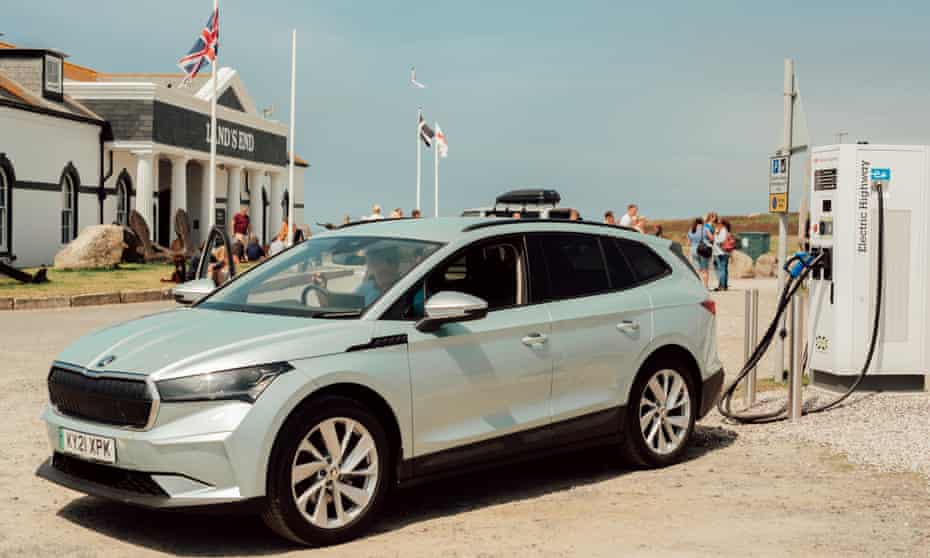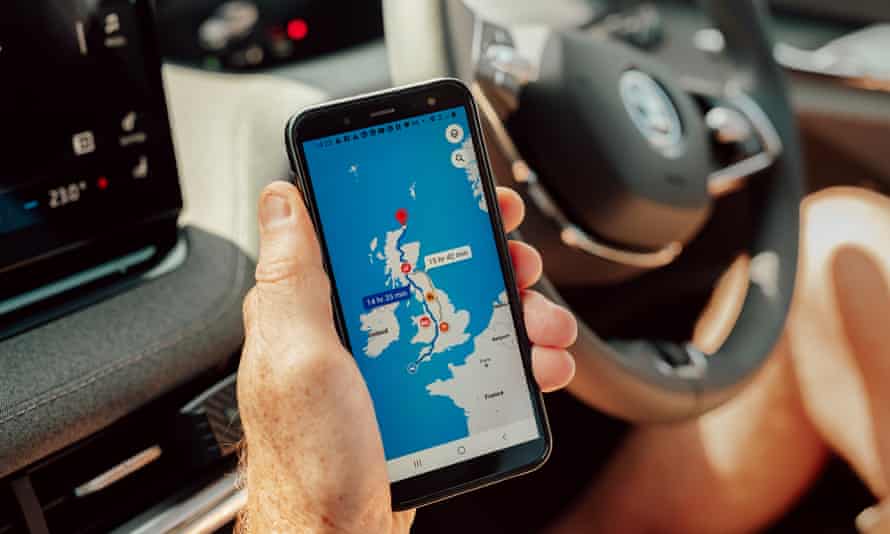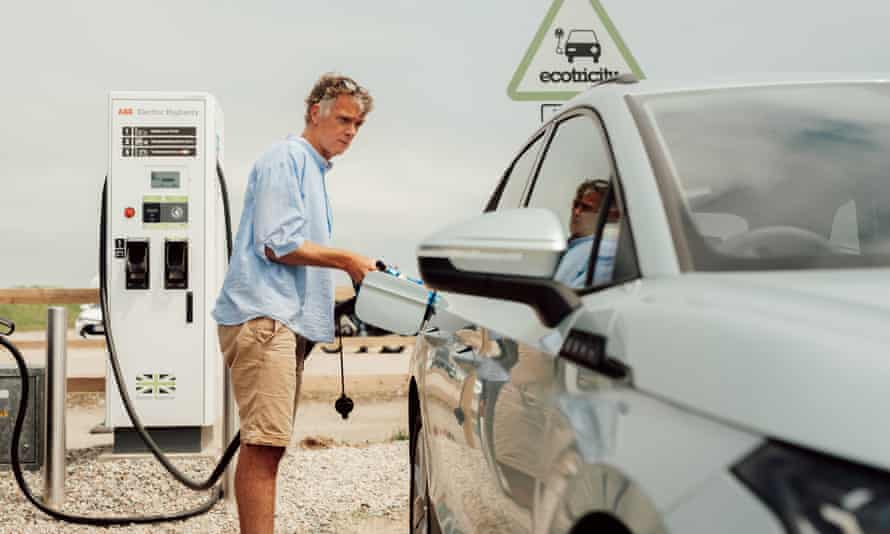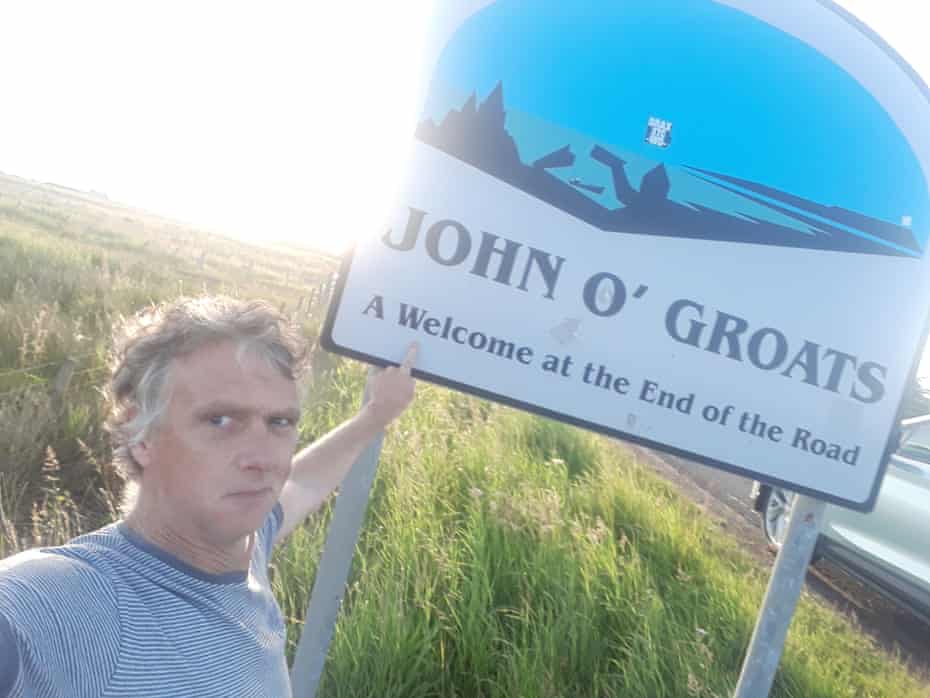Leading the charge! Can I make it from Land’s End to John o’Groats in an electric car?

New petrol and diesel cars will be banned in the UK from 2030, and sales of electric vehicles are rising fast. But with drivers reliant on charging points how practical is the greener option? One writer finds out
Range anxiety hits hard on the A9 in the Highlands of Scotland. For the uninitiated, this is the fear that an electric vehicle (EV) won’t reach its destination before running out of power. I’m driving through some of Britain’s loveliest landscape – mountains, rivers, lochs and firths – but I hardly notice. I’m focused hard – on the road in front, but mainly on two numbers on the dashboard. One is how far it is in miles to where I’m going; the other is the range in miles remaining in the battery. Sometimes, especially on downhill stretches when what is known as “regenerative braking” means the battery is getting charged, I tell myself it’s going to be OK, I’ll make it. But going uphill the range plummets. Squeaky bum time.
Plus, I’ve read Michel Faber’s Under the Skin. I know what happens to men stranded on the A9. To range anxiety add the fear of being processed and eaten by aliens.
It’s the hottest day of the year so far, but I can’t risk the air conditioning, because that immediately wipes about 10% off the range. I’ve heard that opening windows makes a car less aerodynamic, so they remain closed. Sweaty bum time, too. Driving as gently as possible, nursing the car along, barely touching the accelerator or the brake, phone unplugged, radio off, I head north in sweltering, silent panic. Guilt-free, though, on account of being emissions-free at the tailpipe.
I find myself behind a lorry. I tuck in behind, into its slipstream. Potential salvation by Alsop Transport Services of Oban, Argyll. I’m going to surf this baby all the way home. Well, hopefully, all the way to John o’Groats, because that is where I’m heading.
I should say that the predicament I find myself in has less to do with the car I’m driving (a Skoda Enyaq; brilliant) or Britain’s infrastructure for charging EVs (extensive, not brilliant; we’ll come to that) and more about my organisation skills (even less brilliant). Most of the EV charging points in Scotland are run by ChargePlace Scotland. To use them, you sign up and they send you a card to operate the machines. I signed up, but not in time to get the card, so I’m relying on the few charging points not run by ChargePlace Scotland. Well, it will make it more of a challenge, I thought.

I’m driving my Enyaq, a family SUV, from Land’s End to John o’Groats. Why? Several reasons. Of the 30m cars on UK roads, only about 250,000 are purely electric, but that number is going up fast. The Society of Motor Manufacturers and Traders released figures in July showing that sales of new electric cars had jumped 50% in the previous month. EVs will outsell petrol and diesel models by about 2025. The government ban on new petrol and diesel cars has been brought forward, from 2040 to 2030. “However attached you are to your old car, 2030 is coming fast and you’ll be left with a car with no value,” warns Prof Liana Cipcigan of the Electric Vehicle Centre of Excellence at Cardiff University. If you get a new car, it’s increasingly likely to be an electric one. Perhaps you’ve got one already, you’re about to head off on a UK holiday in it and you’re worried. I’m here for you: driving the longest possible route in the country to see if it’s feasible.
It’s not my Enyaq: it has been loaned to me by Skoda. This one costs GBP34,495 to buy, including a GBP2,500 government grant. Still a fair old whack, but EVs are expensive: even a little Renault Zoe costs GBP27,500. The cheapest Tesla is more than 40 grand.
EVs are much cheaper to run than other cars, though. Research by the price comparison website Uswitch found that, if you charge at home, you can squeeze 2,380 miles (3,830km) out of a Nissan Leaf E+ for GBP50. Compare that with only 443 miles for a similar-sized VW Golf. Edmund King, the president of the AA, says that service costs should be lower, too, because EVs are simpler. “The main things are tyres and brakes – there’s very little else in the vehicle. Initially, insurance was expensive, but that seems to be coming down. You don’t pay Vehicle Excise Duty, London congestion charge is free [until December 2025], some authorities give you incentives to park.” He also says that lots of people get EVs on leases, because of uncertainty about battery life and rapidly changing technology.

Enough background facts. You want to hear more about my epic journey, right?
Land’s End is a miserable place: expensive parking before you queue up to pay more to have your photo taken by a signpost. But, more importantly, there is a rapid charger there (Gridserve, 30p/kWh). I can get from low up to 80% in about half an hour, as opposed to hours on a slow charger or at home. So I get a top-up charge. Plus a discharge, from a gull, right on the bonnet – splat. Not an EV fan, apparently. Before the charge, however, I have to wait 45 minutes for a glamorous couple charging their glamorous Tesla. They came down from London, charging it once on the way, although they say they could have done it in one. Yeah, all right, move along now. One of the really annoying things about Teslas is that they have their own special superchargers, sometimes at the same site; other stations are for Teslas only. We, by which I mean non-Tesla EV plebs, can’t use them, whereas they can use ours.
I also meet Amanda and Mike, who have come from York in their electric Kia, having traded in their petrol car for environmental reasons. They get 270 miles on a charge, less in winter. They could have done the journey with one stop, but they put in another. That seems to be a thing among EV drivers: slipping in a cheeky little extra charge, to fend off the anxiety. King doesn’t think range anxiety should be an issue. With new EVs capable, on average, of 200 miles, “that’s going to cover the vast majority of people’s journeys. At the AA, in terms of breakdowns for EVs, only 4% are running out of charge.” Careful, Edmund, I can always bump up that figure a bit.
The Enyaq is nice to drive – quiet, quick when you want it to be – but EVs do make you drive slowly. It’s all about the range. Because I’m new to this, I didn’t do any planning, like where to spend the night. So I spent my first in the car, in a car park on the outskirts of Gloucester, a little Nomadland re-enactment. Here, I cannot recommend the Enyaq. Although the back seats fold down to make quite a big space, there is an annoying step, so I end up reclining the front passenger seat, like on an overnight flight (remember them?).
Back on the M5, then the M6, and more encounters. In Carlisle, I meet Anne-Marie from Newcastle, who is having a weekend away from the kids to go swimming in Ullswater. She loves her five-year-old Nissan Leaf, but gets a range of only 80 miles, so she is stopping off to charge. She drives to work and used to spend GBP175 a month on diesel in her old Audi; now it’s more like GBP25 on charging. But she is starting a new job next week, 85 miles away from home, so Anne-Marie needs to get a new car. What is she going to get? A new-generation Leaf.

At Gretna, I meet Sarah and Phil from Sheffield, on the way to Hamilton races, although they are going to miss the first race because they are having problems charging their Jaguar I-Pace. The charger at home was tripping all the circuits in the house, so they had to have that fixed. “Then trying to find a superfast charger when you’re out and about is not always possible, because they don’t always work,” says Sarah. Phil says too many companies offer charging: “It should have been three or four franchises from the government and it should have all gone on one app.” It’s a common complaint: that the charging infrastructure is confusing and frustrating – some are fast, others slow, some require an app (EV drivers have screens full of apps), some don’t work at all.
My own experience reflects this. In Perth, for example, I identify a BP Pulse point. “Ultra fast charging here,” says the big sign, which, after crossing the Cairngorms, is like reaching an oasis in the desert (I’m limited in my Scottish charging, remember – entirely my own fault). Guess what, though? It doesn’t bloody work. Is it a contactless issue? I download the app, open an account, put GBP20 on it, try again. The man on the helpline reboots the machine, twice. Still no joy. BP No Pulse, I’m calling it. BP Clinically Dead. If you’re reading, BP Pulse, you owe me GBP20.
I have more joy from Ionity round the corner (I soon learn that you always need a backup). That said, on the way back, at the same place, I have problems with the payment and the woman on the helpline gives me a charge on the house. This happens twice on my trip. It’s my No 1 EV tip: always call the hotline. In short, while the physical infrastructure might be there, it’s not quite functioning in an anxiety-free way.
I have quickly become part of the EV community – well intentioned and mostly friendly, but a tiny bit dull. We chat as we charge: about our range, about our favourite and least favourite charging companies. We mostly use the Zap-Maps app, which shows where all the charging points are and lets us plan. There isn’t a lot of room for spontaneity with an EV. A sign to Alton Towers? The Lakes? Or Stirling Castle … No waytime for a visit, because it would mean leaving the route, messing with the plan. Thelma and Louise II: The EV Sequel is going to be a very different and, I think, inferior movie.
But hey, I’m feeling good about saving the planet. I have no emissions coming from my tailpipe – I don’t even have one. Of course, my electricity has to be generated somehow. Currently, that is about 43% renewable in the UK and going up all the time. Plus, the car has to be made and maintained – and there are issues about the mining of lithium and cobalt for batteries. It’s not perfect, but EVs are better than petrol or diesel cars. The sale of hybrids will also end in 2030 – or 2035 if they can travel a significant, yet-to-be-decided distance with zero tailpipe emissions.

When we got a new car (not new-new) a year or so ago, we thought about getting an electric one. But, like 35% of the country’s drivers, we have no off-street parking; we wouldn’t be able to plug in at home. This, says King, is the area that most needs to be addressed. He mentions lamp-post charge points, already available in some places, ducts that go under pavements, empty office blocks where local people could come and charge up cheaply at night. It is getting better – and will continue to do so.
But then I speak to Prof Mike Berners-Lee at Lancaster University, a carbon footprint expert and the author of How Bad Are Bananas?. You know those stingers – the spike strips that the police use to stop cars by puncturing their tyres? Well, Berners-Lee throws one of them across my path – metaphorically speaking, not across the actual A9.
He mentions the burden that the huge increase in EVs will have on the power grid. “If you look at the marginal demand for electricity, it’s not met through extra renewables – that capacity is met through gas.” Boo. The surge in electric cars might make it harder for the grid to decarbonise. “It’s not going to put up solar panels and wind turbines faster – we’re already doing that foot to the floor, and this country has a limited capacity for all that, anyway.”
Cipcigan at Cardiff University agrees that the EV revolution will be challenging to the grid, but argues that it will also offer opportunities. She mentions charging that doesn’t affect the grid in the evening, and how EVs could help with one of the issues with solar – when there is too much power on sunny days. “Electric vehicles could charge in those periods, use up the extra generated. This service could be offered to fleets and vans.”
Berners-Lee isn’t against electric cars – he has just got himself a seven-year-old Renault Zoe. The need for road transport to stop using fossil fuels has never been greater. But he is not convinced that electric was the right way to go. I think I know what is coming: the H word. One of the problems with electricity is that it can’t be produced very far from where it’s needed. Hydrogen, by contrast, could be manufactured using solar power, in the Australian desert, say, then compressed and transported to where it needs to go. “There’s less environmental burden from batteries, quicker charging time, a smaller re-engineering job on the cars themselves [a hydrogen combustion engine isn’t so different from a petrol one], and it allows us to get some of our primary energy from thousands of miles away.”
In the race between E and H on the road to transport decarbonisation, maybe the wrong car got ahead. “Elon Musk has won the argument. But he is promoting space tourism, which is the most ridiculous unnecessary thing you could think of,” says Berners-Lee. Another reason to hate Teslas.
Certainly, he says, hydrogen makes sense with bigger vehicles – vans and lorries, where a battery would have to be way too big. But none of this is helping me right now. One day, the Alsop Transport Services lorry in front of me will hopefully run on hydrogen. But that infrastructure certainly isn’t there. And I’m in an electric car, possibly feeling a bit less smug about it, but mainly still anxious about whether I’m going to make it to my destination.

I spend another night in the car, in a fishing village 50 miles short of John o’Groats. To the people of Helmsdale, I apologise for my alarm, which kept going off throughout the night; the car thought I was stealing it, from the inside. In the early morning, I set off on the final leg, gently milking the Enyaq’s battery of its remaining charge. No lorry today, but the terrain gets flatter, the anxiety eases and it becomes clear that I’m probably going to make it.
Which I do, with six miles to spare. I’ve done 231 miles since the last charge in Perth, 843 miles from Land’s End, about 290kWh in total, if that means anything to you, which has cost me about GBP88. Charging at home, at low tariff rates, would have been much less. There is another signpost for picture opportunities at John o’Groats: nothing to pay, no queue, oystercatchers instead of gulls. And, best of all, a working EV charger.
